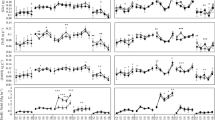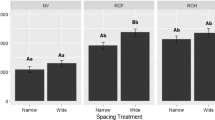Abstract
The C4 perennial grasses Miscanthus × giganteus and Panicum virgatum (switchgrass) are emerging bioenergy crops. They are attractive because they are productive and recycle nutrients to the overwintering belowground rhizomes, before the dry shoots are harvested. They are therefore expected to require minimal fertilizer inputs, a desirable trait for any crop. Until now, Europe has had the only long-term trials of M. × giganteus, and these have either shown no or a small effect of nitrogen fertilization, while trials of P. virgatum in the USA have shown a clear positive effect of N fertilization. This study exploited the first long-term trials of M. × giganteus in the USA, and first side-by-side comparison with P. virgatum, to test the hypothesis that N fertilization would only improve yields of the latter. A split-plot N fertility treatment (0, 67, 134, and 202 kg(N) ha−1) was added to >5-year-old replicated stands of the two crops at seven locations on contrasting soils in the US Midwest. Averaged across all locations, M. × giganteus yields increased significantly from 23.4 Mg ha−1 with no N fertilization to 28.9 Mg ha−1 (+25 %) at a N application rate of 202 kg ha−1. P. virgatum also showed significant yield increases from 10.33 Mg ha−1 at 0 kg(N) ha−1 to 13.6 Mg ha−1 (+32 %) at 202 kg(N) ha−1. Both species therefore responded to N fertilization and to a similar extent. The increase per unit of added N was small compared to crops such as Zea mays and unlikely to be economically worthwhile. Nitrogen fertilization arrested most of the long-term yield decline that would otherwise have occurred in P. virgatum, but eliminated only about 40 % of the decline observed in M. × giganteus, suggesting additional causal factors for long-term yield decline in this crop. While the crops responded to nitrogen addition at some locations, they did not at others. Therefore a one-case-fits-all optimum fertilization rate cannot be prescribed.





Similar content being viewed by others
References
Acaroğlu M, Şemi Aksoy A (2005) The cultivation and energy balance of Miscanthus × giganteus production in Turkey. Biomass Bioenergy 29:42–48
Aherne J, Farrell EP (2000) Synthesis report: determination and mapping of critical loads for sulphur and nitrogen and critical levels for ozone in Ireland. Environmental Protection Agency, Dublin, 33pp
Angelini LG, Ceccarini L, Nassi o Di Nasso N, Bonari E (2009) Comparison of Arundo donax L. and Miscanthus × giganteus in a long-term field experiment in Central Italy: analysis of productive characteristics and energy balance. Biomass Bioenergy 33:635–643
Arundale RA, Dohleman FG, Heaton EA, Mcgrath JM, Voigt TB, Long SP (2013) Yields of Miscanthus × giganteus and Panicum virgatum decline with stand age in the Midwestern USA. Glob Chang Biol Bioenergy. doi:10.1111/gcbb.12077
Beale CV, Long SP (1997) Seasonal dynamics of nutrient accumulation and partitioning in the perennial C-4-grasses Miscanthus × giganteus and Spartina cynosuroides. Biomass Bioenergy 12:419–428
Cadoux S, Riche AB, Yates NE, Machet J-M (2011) Nutrient requirements of Miscanthus × giganteus: conclusions from a review of published studies. Biomass Bioenergy 38:14–22
Christian DG, Poulton P, Riche AB, Yates NE, Todd A (2006) The recovery over several seasons of 15N-labelled fertilizer applied to Miscanthus × giganteus ranging from 1 to 3 years old. Biomass Bioenergy 30:125–133
Christian DG, Riche AB, Yates NE (2002) The yield and composition of switchgrass and coastal panic grass grown as a biofuel in southern England. Bioresour Technol 83:115–24
Christian DG, Riche AB, Yates NE (2008) Growth, yield and mineral content of Miscanthus × giganteus grown as a biofuel for 14 successive harvests. Ind Crop Prod 28:320–327
Clifton-Brown JC, Breuer J, Jones MB (2007) Carbon mitigation by the energy crop, Miscanthus. Glob Chang Biol 13:2296–2307
Cosentino SL, Patanè C, Sanzone E, Copani V, Foti S (2007) Effects of soil water content and nitrogen supply on the productivity of Miscanthus × giganteus Greef et Deu. in a Mediterranean environment. Ind Crop Prod 25:75–88
Davis SC, Parton WJ, Dohleman FG, Smith CM, Grosso SD, Kent AD, DeLucia EH (2009) Comparative biogeochemical cycles of bioenergy crops reveal nitrogen-fixation and low greenhouse gas emissions in a Miscanthus × giganteus agro-ecosystem. Ecosystems 13:144–156
Dohleman FG, Heaton EA, Arundale RA, Long SP (2012) Seasonal dynamics of above- and below-ground biomass and nitrogen partitioning in Miscanthus × giganteus and Panicum virgatum across three growing seasons. GCB Bioenergy 4:534–544
Dohleman FG, Long SP (2009) More productive than maize in the Midwest: how does Miscanthus do it? Plant Physiol 150:2104–2115
Eckert B, Weber OB, Kirchhof G, Halbritter A, Stoffels M, Hartmann A (2001) Azospirillum doebereinerae sp. nov., a nitrogen-fixing bacterium associated with the C4-grass Miscanthus. Int J Syst Evol Microbiol 51:17–26
Ercoli L, Mariotti M, Masoni A, Bonari E (1999) Effect of irrigation and nitrogen fertilization on biomass yield and efficiency of energy use in crop production of Miscanthus. Field Crop Res 63:3–11
Fernández FG, Nafziger ED, Ebelhar SA, Hoeft RG (2012) Managing Nitrogen. In: Nafziger ED (ed) Illinois agronomy handbook. University of Illinois Extension, Urbana, pp 113–132
Fike JH, Parrish DJ, Wolf DD, Balasko JA, Green JT Jr, Rasnake M, Reynolds JH (2006) Long-term yield potential of switchgrass-for-biofuel systems. Biomass Bioenergy 30:198–206
Gezgin S, Bayrakll F (1995) Ammonia volatilization from ammonium sulphate, ammonium nitrate, and urea surface applied to winter wheat on a calcareous soil. J Plant Nutr 18:2483–2494
Goulding KWT, Bailey NJ, Bradbury NJ et al (1998) Nitrogen deposition and its contribution to nitrogen cycling and associated soil processes. New Phytol 139:49–58
Greef JM, Deuter M (1993) Syntaxonomy of Miscanthus × giganteus Greef et Deu. Angew Bot 67:87–90
Heaton EA, Clifton-Brown JC, Voigt TB, Jones MB, Long SP (2004) Miscanthus for renewable energy generation: European Union experience and projections for Illinois. Mitig Adapt Strateg Glob Chang 9:433–451
Heaton EA, Dohleman FG, Long SP (2008) Meeting US biofuel goals with less land: the potential of Miscanthus. Glob Chang Biol 14:2000–2014
Heaton EA, Dohleman FG, Long SP (2009) Seasonal nitrogen dynamics of Miscanthus × giganteus and Panicum virgatum. Glob Chang Biol Bioenergy 1:297–307
Heaton EA, Voigt TB, Long SP (2004) A quantitative review comparing the yields of two candidate C4 perennial biomass crops in relation to nitrogen, temperature and water. Biomass Bioenergy 27:21–30
Heggenstaller AH, Moore KJ, Liebman M, Anex RP (2009) Nitrogen influences biomass and nutrient partitioning by perennial, warm-season grasses. Agron J 101:1363–1371
Himken M, Lammel J, Neukirchen D, Olfs H (1997) Cultivation of Miscanthus under West European conditions: seasonal changes in dry matter production, nutrient uptake and remobilization. Plant Soil 189:117–126
Hodkinson TR, Renvoize S (2001) Nomenclature of Miscanthus × giganteus (Poaceae). Kew Bull 56:759–760
Holland EA, Braswell BH, Sulzman J, Lamarque J-F (2005) Nitrogen deposition onto the United States and Western Europe: synthesis of observations and models. Ecol Appl 15:38–57
Illinois State Water Survey (2003) Alternative crop suitability maps. Illinois State Water Survey, Champaign
Illinois State Water Survey (2009) National atmospheric deposition program. Illinois State Water Survey, Champaign
Kering MK, Butler TJ, Biermacher JT, Guretzky JA (2012) Biomass yield and nutrient removal rates of perennial grasses under nitrogen fertilization. Bioenergy Res 5:61–70
Lewandowski I (2003) The development and current status of perennial rhizomatous grasses as energy crops in the US and Europe. Biomass Bioenergy 25:335–361
Littell RC, Milliken GA, Stroup WW, Wolfinger RD, Schabenberger O (2006) SAS for mixed models. SAS Institute, Inc., Cary
Ma Z, Wood CW, Bransby DI (2001) Impact of row spacing, nitrogen rate, and time on carbon partitioning of switchgrass. Biomass Bioenergy 20:413–419
Mantineo M, D’Agosta GM, Copani V, Patanè C, Cosentino SL (2009) Biomass yield and energy balance of three perennial crops for energy use in the semi-arid Mediterranean environment. Field Crop Res 114:204–213
Martikainen PJ (1985) Nitrification in forest soil of different pH as affected by urea, ammonium sulphate and potassium sulphate. Soil Biol 17:363–367
Maughan M, Bollero GA, Lee DK et al (2011) Miscanthus × giganteus productivity: the effects of management in different environments. Glob Chang Biol Bioenergy. doi:10.1111/j.1757-1707.2011.01144.x
Mclaughlin SB, Kszos LA (2005) Development of switchgrass (Panicum viragtum) as a bioenergy feedstock in the United States. Biomass Bioenergy 28:515–535
Miguez FE, Villamil M, Long SP, Bollero GA (2008) Meta-analysis of the effects of management factors on Miscanthus × giganteus growth and biomass production. Agric For Meteorol 148:1280–1292
Miyamoto T, Kawahara M, Minamisawa K (2004) Novel endophytic nitrogen-fixing clostridia from the grass Miscanthus sinensis as revealed by terminal restriction fragment length polymorphism analysis. Appl Environ Microbiol 70:6580–6586
Muir JP, Sanderson MA, Ocumpaugh WR, Jones RM, Reed RL (2001) Biomass production of “Alamo” switchgrass in response to nitrogen, phosphorus, and row spacing. Agron J 93:896–901
Nafziger ED, Fernández F, Adee E, Dunker RE, Ebelhar SA, Paul LE (2009) Assessing variability in corn response to N rate. In: Illinois Fertilizer Conference Proceedings
Nafziger ED, Fernández F, Adee E, Dunker RE, Ebelhar SA, Paul LE (2010) Assessing variability in corn response to N rate: soil residual effects following 10 years of trials. In: Illinois Fertilizer Conference Proceedings
Parrish DJ, Fike JH (2005) The biology and agronomy of switchgrass for biofuels. Crit Rev Plant Sci 24:423–459
Propheter JL, Staggenborg S (2010) Performance of annual and perennial biofuel crops: nutrient removal during the first two years. Agron J 102:798–805
Sawyer J (2007) Nitrogen fertilization for corn following corn. Integr Crop Manag 498:27–28
Sawyer J, Nafziger E, Randall G et al. (2006) Concepts and rationale for regional nitrogen rate guidelines for corn concepts and rationale for regional nitrogen rate guidelines for corn. Iowa Library Services, http://publications.iowa.gov/id/eprint/3847. Accessed 4 Mar 2013
Schwarz H, Liebhard P, Ehrendorfer K, Ruckenbauer P (1994) The effect of fertilization on yield and quality of Miscanthus sinensis “Giganteus. Ind Crop Prod 2:153–159
US Department of Agriculture-ERS (2012) Fertilizer use and price. USDA-Economic Research Service, Washington, DC, http://www.ers.usda.gov/data-products/fertilizer-use-and-price.aspx. Accessed 1 May 2013
U.S. Department of Agriculture (USDA) Natural Resources Conservation Service (2003) National Soil Survey Handbook, part 622: Ecological and interpretative groups. USDA, Washington, D.C., p 16
U.S. Department of Agriculture (USDA) Natural Resources Conservation Service (2012) Web soil survey. USDA, Washington, D.C.
Vogel KP, Brejda JJ, Walters DT, Buxton DR (2002) Switchgrass biomass production in the Midwest USA: harvest and nitrogen management. Agron J 94:413–420
Wang D, Lebauer DS, Dietze MC (2010) A quantitative review comparing the yield of switchgrass in monocultures and mixtures in relation to climate and management factors. Glob Chang Biol Bioenergy 2:16–25
Wetselaar R, Passiora JB, Singh BR (1972) Consequences of banding nitrogen fertilizers in soil I. Effects on nitrification. Plant Soil 36:159–175
Ye B, Saito A, Minamisawa K (2005) Effect of inoculation with anaerobic nitrogen-fixing consortium on salt tolerance of Miscanthus sinensis. Soil Sci Plant Nutr 51:243–249
Author information
Authors and Affiliations
Corresponding author
Rights and permissions
About this article
Cite this article
Arundale, R.A., Dohleman, F.G., Voigt, T.B. et al. Nitrogen Fertilization Does Significantly Increase Yields of Stands of Miscanthus × giganteus and Panicum virgatum in Multiyear Trials in Illinois. Bioenerg. Res. 7, 408–416 (2014). https://doi.org/10.1007/s12155-013-9385-5
Published:
Issue Date:
DOI: https://doi.org/10.1007/s12155-013-9385-5




